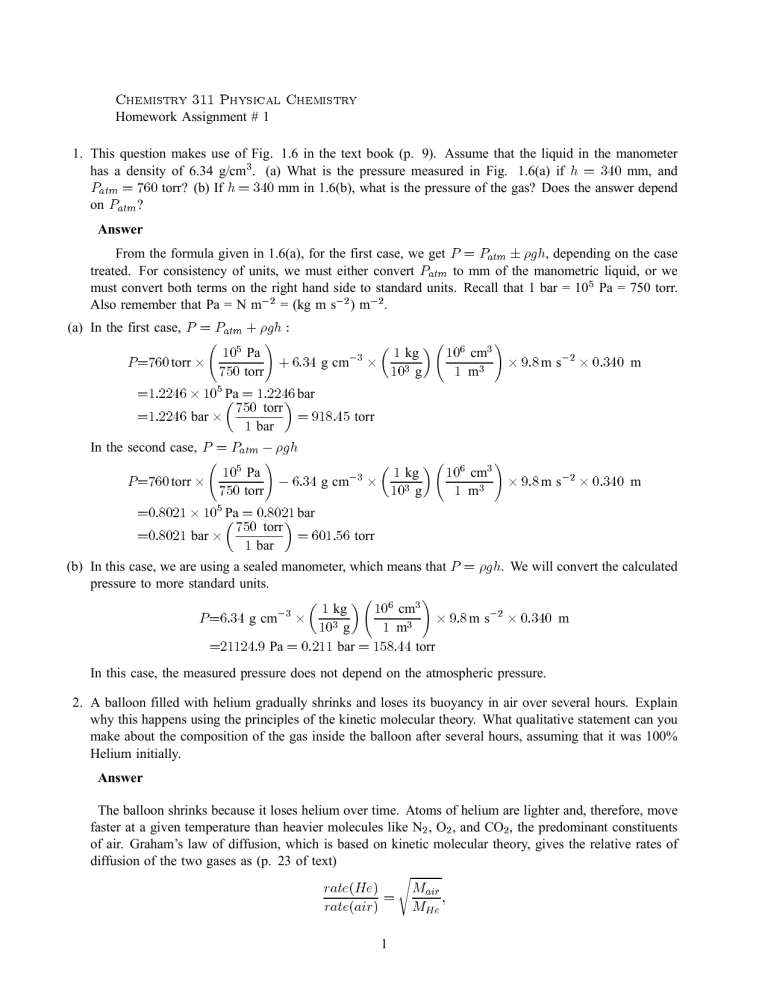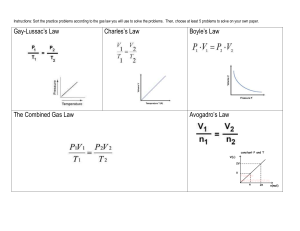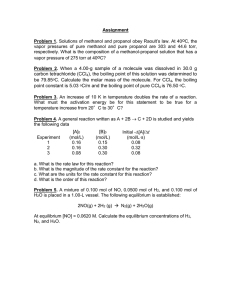
Chemistry 311 Physical Chemistry Homework Assignment # 1 1. This question makes use of Fig. 1.6 in the text book (p. 9). Assume that the liquid in the manometer has a density of 6.34 g/cm3. (a) What is the pressure measured in Fig. 1.6(a) if h = 340 mm, and Patm = 760 torr? (b) If h = 340 mm in 1.6(b), what is the pressure of the gas? Does the answer depend on Patm ? Answer From the formula given in 1.6(a), for the first case, we get P = Patm ± ρgh, depending on the case treated. For consistency of units, we must either convert Patm to mm of the manometric liquid, or we must convert both terms on the right hand side to standard units. Recall that 1 bar = 105 Pa = 750 torr. Also remember that Pa = N m−2 = (kg m s−2 ) m−2. = Patm + ρgh : 1 kg 106 cm3 5 Pa 10 − 3 −2 P =760 torr × 750 torr + 6 34 g cm × 103 g 1 m3 × 9 8 m s × 0 340 =1 2246 × 105 Pa = 1 2246 bar 750 =1 2246 bar × 1 bartorr = 918 45 torr In the second case, = atm − ρgh (a) In the first case, P . . . . m . . . P P =760 torr × P 105 Pa 750 torr − 6.34 g cm−3 × 1 kg 103 g × 105 Pa = 0.8021 bar 750 torr =0.8021 bar × = 601.56 torr 1 bar 106 cm3 1 m3 × 9.8 m s−2 × 0.340 m =0.8021 (b) In this case, we are using a sealed manometer, which means that P pressure to more standard units. = ρgh. We will convert the calculated kg 106 cm3 × 9.8 m s−2 × 0.340 m 103 g 1 m3 =21124.9 Pa = 0.211 bar = 158.44 torr P =6.34 g cm−3 × 1 In this case, the measured pressure does not depend on the atmospheric pressure. 2. A balloon filled with helium gradually shrinks and loses its buoyancy in air over several hours. Explain why this happens using the principles of the kinetic molecular theory. What qualitative statement can you make about the composition of the gas inside the balloon after several hours, assuming that it was 100% Helium initially. Answer The balloon shrinks because it loses helium over time. Atoms of helium are lighter and, therefore, move faster at a given temperature than heavier molecules like N2 , O2 , and CO2, the predominant constituents of air. Graham’s law of diffusion, which is based on kinetic molecular theory, gives the relative rates of diffusion of the two gases as (p. 23 of text) rate(He) rate(air) = 1 Mair , MHe where it is understood that Mair refers to a weighted average of the molecular masses of N2 , O2 , and CO2 , and other trace gases. Also, He atoms are smaller than the molecules in air, and diffuse through the pores of the balloon more readily. The net effect is that the balloon loses helium, and only a part of that loss is replaced by air diffusing in. As a result, the balloon shrinks in size, and loses buoyancy. 3. One mole of a gas at 5.69 bar and 282 K is found to be in a corresponding state with Methane at 4 bar and 300 K. From the table of critical constants given on p. 24 of the textbook, identify the gas. Answer Since the two gases are in corresponding states, their reduced pressures and temperatures are equal. For methane, TC = 190.6 K, PC = 46.4 bar. Therefore, R= T 300 190.6 = 1.574; R= P 4.0 46.4 = 0.0862 For the unknown gas, C T C P T = = R T P R P = = 288 K 1.574 5.69 bar 0.0862 = 182.9 = 66.0 K bar From the table of critical constants, the unknown gas is identified to be NO. 4. (a) The Virial coefficient B (T ) of carbon dioxide is −149.7 cm3 mol−1 at 0◦C. Compare its compressibility factor Z at this temperature and 1 bar with that of an ideal gas. [Hint: Substitute for V in terms of the ideal gas law on the right hand side of Eq. (1.117) to get an equation similar to Eq. (1.116); ignore terms containing P 2 and higher powers of P .] (b) Calculate the second Virial coefficient of Methane at 300 K from its van der Waals constants (see Table 1.5), using the relationship obtained from Problem 1.55 of the textbook, and calculate the compressibility factor at 300 K and 1 bar. Answer (a) From Eq. (1.118), substituting V = nRT /P , we get an approximate expression in terms of pressure: = 1 + B (T ) Z = 1+ 1+ −149 7 cm3 mol−1 × 1 0 L . . /1000 B V 3 RT cm 0.083145 L bar K−1 mol−1 × 273 K n P + ... + ... × 1 bar = 0.9934 The compressibility factor for an ideal gas would be identically equal to 1. (b) The van der Waals constants for methane: a = 0.2283 Pa m6 mol−2 = 2.283 bar L2 mol−2 , and b = 0.0428 × 10−3 m3 mol−1 = 0.0428 L mol−1 . From the solution to the assigned problem (1.55) in the text, −0 0487 L mol−1. 2 L2 mol−2 = 1 83 × 10−3 L2 mol−2 B (T ) C (T ) = = (b − a RT b )= . 2 . Compressibility factor is Z Substituting for Vm = RT /P = 1 + (b a RT ) 1 m V 2 1 +b + ... V2 m , we get Z =1 − = 1 + (b − a RT ) P RT 2 + b 2 P + ... (RT )2 − 0 0487 L mol−1 × 0 08314 L bar K1 −bar 1 mol−1 × 300 K − 3 L2 mol−2 1 83 × 10 + 2 (0 083145 L bar K−1 mol−1 × 300 K) . . . . = 0.9981 3






